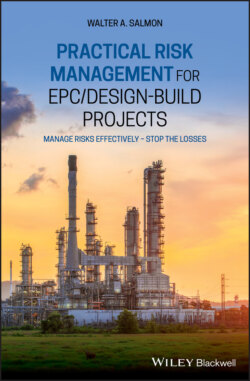Читать книгу Practical Risk Management for EPC / Design-Build Projects - Walter A. Salmon - Страница 25
2.4.5 General Notes of Interest
ОглавлениеNot all EPC Projects will require the Contractor to be responsible for commissioning the facility, and the ‘turnkey’ tag cannot therefore be applied if that situation applies to the Project. This will often occur where the completed facility requires hydrocarbons or special processing materials to be used that have the potential to cause harm if not handled correctly (and where specialists will often be engaged by the Employer to take responsibility for the commissioning work). This has therefore caused the term ‘EPCC’ to arise, where the final ‘C’ refers to ‘Commissioning’, making the whole read ‘Engineering, Procurement, Construction and Commissioning’. However, this is an unnecessary appendage, since the specific requirements for each EPC Project are unique, and the scope of work definitions written into the contractual documentation will usually define the actual work content for the Contractor. In particular, the FIDIC contracts (the Silver and Yellow Books) do not make any references therein to Procurement (nor Engineering, nor Construction), thus any specific requirements for those activities must be separately specified elsewhere in the documents that form the basis of the contractual agreement between the parties. Consequently, if using either of those FIDIC publications, it is therefore sufficient to describe the contract as being for an ‘EPC’ Project, even where the Contractor is not required to undertake the commissioning work. The same reasoning applies to the term ‘EPCI’, where the ‘I’ refers to ‘Installation’ (thus ‘Engineering, Procurement, Construction and Installation’); again, this distinction is unnecessary for the reasons given for not using the term ‘EPCC’. Despite that, I am sure that such variations in the abbreviations used will continue to be employed widely.
In the past, many EPC Contracts were of the reimbursable type, where the Contractor was recompensed in full for all manpower and construction equipment resources used, as well as for all purchases made for the Project. However, those halcyon days for Contractors have generally long-since gone at the time of writing this book and, sadly for Contractors, may not return for many years to come. Nowadays, the tendency is for Employers to insist upon agreeing a lump-sum price with the EPC Contractor for the whole of the Project's implementation. That is an arrangement that almost always benefits the Employer much more than it does the Contractor. This book therefore focuses solely on Projects undertaken on the basis of a lump-sum payment arrangement. In addition, as mentioned in Section 1.1, this book assumes that the EPC Project is to be built in an overseas developing country, since that type of Project is far more difficult to manage than one planned to be built in the Contractor's own backyard.
Much as for the Design-Build approach, the EPC approach has many variants and is a deep subject once you decide to get into exploring its possibilities. Unfortunately however, as late as when I was completing the writing of this book (early 2019), I have to say I still found Wikipedia did not provide suitable reference material about EPC Projects. So much so, that I will not put any direct references to the Wikipedia article here, since I do not wish to waste anybody's time or, worse, for anybody to get confused. Having said that, if a Google search is conducted for the phrase ‘EPC Projects’, you will see that in the order of 18 000 000 references can be found by the search engine. Having myself opened and read in excess of what I thought were the best 200 or so links displayed by Google, I found that there is a lot of inadequate material on the Internet in respect of EPC Projects. Where I found good material, I have made appropriate reference to it in this book.
